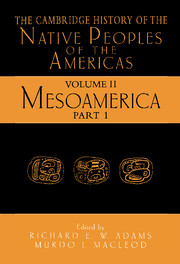Book contents
- Frontmatter
- Contents
- List of Illustrations
- Part I
- 1 Introduction to a Survey of the Native Prehistoric Cultures of Mesoamerica
- 2 The Paleoindian and Archaic Cultures of Mesoamerica
- 3 The Preclassic Societies of the Central Highlands of Mesoamerica
- 4 The Precolumbian Cultures of the Gulf Coast
- 5 The Maya Lowlands: Pioneer Farmers to Merchant Princes
- 6 The Central Mexican Highlands from the Rise of Teotihuacan to the Decline of Tula
- 7 Western and Northwestern Mexico
- 8 Cultural Evolution in Oaxaca: The Origins of the Zapotec and Mixtec Civilizations
- 9 The Southeast Frontiers of Mesoamerica
- 10 The Maya Highlands and the Adjacent Pacific Coast
- 11 The Aztecs and Their Contemporaries: The Central and Eastern Mexican Highlands
- Index
4 - The Precolumbian Cultures of the Gulf Coast
Published online by Cambridge University Press: 28 March 2008
- Frontmatter
- Contents
- List of Illustrations
- Part I
- 1 Introduction to a Survey of the Native Prehistoric Cultures of Mesoamerica
- 2 The Paleoindian and Archaic Cultures of Mesoamerica
- 3 The Preclassic Societies of the Central Highlands of Mesoamerica
- 4 The Precolumbian Cultures of the Gulf Coast
- 5 The Maya Lowlands: Pioneer Farmers to Merchant Princes
- 6 The Central Mexican Highlands from the Rise of Teotihuacan to the Decline of Tula
- 7 Western and Northwestern Mexico
- 8 Cultural Evolution in Oaxaca: The Origins of the Zapotec and Mixtec Civilizations
- 9 The Southeast Frontiers of Mesoamerica
- 10 The Maya Highlands and the Adjacent Pacific Coast
- 11 The Aztecs and Their Contemporaries: The Central and Eastern Mexican Highlands
- Index
Summary
INTRODUCTION
The Gulf Coast lowlands form one of Mesoamerica’s richest and most diverse regions. The equally rich and distinctive precolumbian societies that occupied the region played a crucial role in the development of the Mesoamerican cultural tradition. During three millennia preceding the Spanish conquest the region oscillated between epochs of cultural leadership when Gulf Coast societies occupied a strategic position in the pan- Mesoamerican world and periods of stagnation, isolation, and even foreign intrusions when outsiders, generally from highlands of central Mexico, dominated its people and resources. Much of the region’s history reflects dynamic processes in which local innovation and growth alternated with foreign infringement. Thus, the Spaniards’ use of the region as a staging area for their conquest of Mexico was merely the one act in a saga of cultural interaction that began when maize and other highland plants were first taken to the lowlands five thousand years ago and that still continues today.
The key to this history lies in the region’s wealth and resources, specifically land, food, exotic luxury goods, and trade routes. The Aztecs understood this clearly when they made conquest of the region a top priority early in their imperial history. Their vision of the region’s wealth is reflected in their names for it: Tamoanchan (an untranslatable name suggestive of a mythical Utopia or earthly paradise), Tonacatlalpan “Land of Food,” and Tlalocan “Place of Wealth” (Sahagun Book 2: 208-9, 226). Fray Bernardino de Sahagun’s Aztec informants described the inhabitants of the southern Gulf Coast lowlands as follows: “These were rich, their home, their land, was really a land of riches, a land of flowers, a land of abundance. There was all manner of food; there grew the cacao bean, and the ‘divine ear’ spice, and wild cacao, and liquid rubber” (Sahagun Book 10: 187). Adjacent lowland zones were described in equally glowing terms. Thus, the outstanding cultural developments of the region’s cultures and the desires of its neighbors to control its wealth are not surprising, and these two recurrent themes account for the area’s tremendous importance in precolumbian times.
THE REGION AND ITS CHARACTERISTICS
Mesoamerican’s Gulf Coast lowlands extend southeast from Mexico’s border with the United States to the Yucatan Peninsula, but this chapter deals only with the region between the Soto la Marina River, approximately 200 kilometers north of modern Tampico, and the swampy floodplain of western Tabasco (Map 4.1).
- Type
- Chapter
- Information
- The Cambridge History of the Native Peoples of the Americas , pp. 156 - 196Publisher: Cambridge University PressPrint publication year: 2000
- 7
- Cited by



